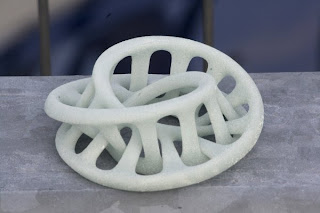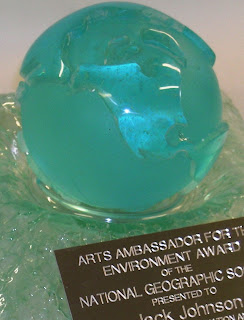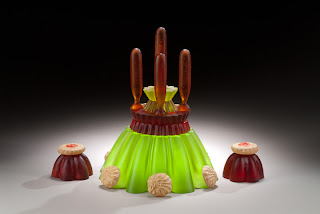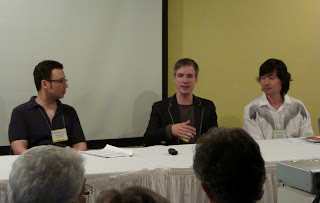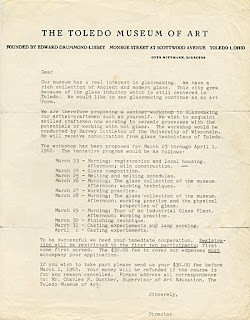>The recent posting about 3D printer technology and the resulting roving robots amuck in the Sahara, leaving a trail of glassware had generated a lot of inquiries into the 3D technology (and interest in how does one get access to this). Recently, a high-tech fabrication/prototype workshop has opened in Washington, DC: Fab Lab DC
From their website:
Fab Labs provide access to prototype tools for personal
fabrication, like a personal computer that can output
functional objects instead of images on a screen.
The labs have spread from inner-city Boston to Africa and
Norway, with projects tackling applications in areas
including healthcare,agriculture, housing, and communications...
In the spirit of MIT’s Fab Lab community outreach project,
FAB LAB DC will create a high-tech,fabrication
laboratory/community workshop in the heart of the
Nation’s Capital to advance creativity, innovation, and
collaborative projects. FAB LAB DC will serve and foster
the creative community by providing access to digital
fabrication technology, rapid prototyping,and the global
Fab Lab network.
There are some other online sites that allow one to upload files that
they will fabricate and ship to you - like Shapeways - a
Netherlands based site that now has opened offices in NYC.
Shapeways also has glass prototype facilities - but they have a
list of of rules for this process.
Click HERE to jump to Fab Lab DC's website.
Click HERE to jump to Fab Lab blog.
ReadysetDC on Washington Glass School
>
The hip and trendy culture blog – ReadysetDC just covered the Washington Glass School 10th anniversary exhibition at Long View Gallery with an in-depth review of the show with insights about the Washington Glass School directors and DC GlassWorks’ Dave D’Orio.
Writer Natalie Stemp has some thoughtful takes on the changing status of glass as a sculptural medium:
“Let’s play a game. If I say “canvas”, what do you picture? You probably imagine art – Vermeer, Seurat, Picasso, Mondrian, maybe even DC’s Chris Martin. What if I say “glass”? Do the words “sink, wine, stained” instantly light up like neon signs? If so, you are not alone, but the Washington Glass School (WGS) wishes you were.
The Studio Glass Movement was founded just 50 years ago, so it is not surprising that most of us still perceive glass art strictly as decorative. In fact, the WGS – the face of the Movement in DC along with DC GlassWorks – celebrated its 10 year anniversary last weekend with a reception at Longview Gallery that concluded a month-long retrospective exhibition. After touring the exhibition with Michael Janis, co-director of WGS, I find it difficult to understand why the art establishment struggles to include consistent representation of expressive glass art at preeminent shows and museums. Think about the museums you visited in the past year: did any of them include contemporary glass art in its curation?…”
Natalie’s article contains many photos taken from the exhibition and comments about the featured artist’s work.
ReadysetDC is an online zine dedicated to the creative revolution and movement that is happening in Washington, DC.
Click HERE to jump to ReadysetDC’s article.
Solar Powered 3D Printer Turns Sand Into Glass
>Solar Sintar
Markus Kayser – Solar Sinter Project from Markus Kayser on Vimeo.
If you have been like me, you spend every possible hour in the studio – head down, working on artwork and projects. The world, my friend, however, has been marching on. New technologies are reshaping how art is made.
In this brave new world, 3D printers top every sculptors must-have list.
The model above is Emmanuel Lattes’ Double Möbius. 3D printed in glass. Glass frit powder is mixed with a binding agent that allows the work to be modeled and built by layers in a 3D printer. The work is then carefully loaded into a kiln and fired, fusing the powder and burning away the binding agent. Tho a bit more fragile and rougher than traditional glass forming, the possibilities of computer assisted sculpture are incredible.
But to put all this progress into perspective, a little history is in order. The first 3D printer was produced by Charles Hull in 1984, who utilized a patented stereolithography method for the print process. The basic approach for 3D printing is to create a layer of polymer for the desired 2D slice, cure that area, and then repeat to build layer-upon-layer. Hull’s technique involved creating a 0.0025-inch layer of liquid photocurable polymer that could be cured with a UV laser.
In 1988, the first commercially available 3D printer was officially launched by 3D Systems, which utilized a photo-optical acrylic resin. In the early 1990s, a number of other methods were developed, including fused deposition modeling that extruded thermoplastics for layering and multi-jet modeling, based on ink-jet printer technology. Techniques have also been developed that use powder and lasers. Over time, a multitude of companies across the world have sprung up offering their high-end printers combined with CAD software and scanners, allowing objects to be either scanned or designed from scratch.
In the above video, Markus Kayser goes into the Sahara with a solar powered printer to create 3D objects – including a bowl – by melting the sand that he scoops up. What an idea for the Glass School’s bowl class! (& class outdoors!). But, you may ask, what about annealing?
Awesome to get a glimpse of the future of both sculpture and sustainable design.
For more about 3D printing – click HERE to jump to a recent article in The Economist.
The Process: National Geographic’s Environment Award
>This posting is the first of a new feature for the Washington Glass School blog: ‘The Process’.
The occasional series will present a photo documentation of a project from start (or at least when we remembered to get a camera going) to finish, highlighting the steps, process and techniques involved. Mistakes, dramas, and screw-ups will be magically deleted from the documentation postings, naturally.
Our first of the series is a focus on the making of National Geographic’s newest award – the ‘National Geographic Arts Ambassador for the Environment Award’ . The recipient for the inaugural award is musician Jack Johnson.
Uber-mellow singer-songwriter-surfer-filmmaker Jack Johnson has dedicated himself to environmental causes, including educational initiatives and promoting eco-friendly touring in the music industry.
Musician and environmental activist Jack Johnson was to receive the newly created “Arts Ambassador for the Environment Award,” presented to an individual in the entertainment field who has demonstrated leadership in environmental and cultural conservation by elevating issues of sustainability and inspiring audiences to care about the planet. Jack Johnson grew up surfing and playing guitar in Hawaii. He released his first album in 2001 and, in the last ten years, has released 5 more albums that have sold over 20 million copies worldwide. In 2003, Jack and his wife Kim founded the Kokua Hawaii Foundation and Kokua Festival to support environmental education in Hawaii’s schools and communities. In 2008, Jack donated 100% of his tour profits to establish the Johnson Ohana Charitable Foundation, an endowment founded by Jack and Kim Johnson to support environmental, art and music education worldwide. These tour profits, along with Johnson’s personal charitable activities, have resulted in millions donated to charity since 2001.
In keeping with the environmental conscious theme, the National Geographic Society asked for an award that was made from recycled glass, and a number of designs were studied.

As the award was to be yearly, the concepts had to allow for art ambassadors that worked in areas of interest such as “oceans” or “forests” or “wildlife” and be able to relate equally to those themes. Early on, a globe shape was favored by the National Geographic award committee. Recycled float (window) glass was to be cast using the lost wax process. The National Geographic committee stipulates that the cast glass globe be removable, and options for the support base are explored.
The Process:
Spraying the clay original with a mold release agent.
Pouring the rubber mold compound around the original clay form.
After setting up – preparing to cut open the rubber mold and remove the clay form. After removal of the clay, melted wax is poured into the rubber mold, and a wax copy of that form is removed.
The wax original is coated with with layers of a plaster/silica mix, building up the form until a solid covering is achieved.
The plaster/silica form is allowed to set up. Once hardened, the wax is melted out – the essence of the ‘lost wax’ process.
Checking the mold for any wax residue.
Recycled float glass is cleaned and made ready for casting.
The molds are loaded into the electric kilns and glass placed into ceramic pot reservoirs. The glass globes go through a six day annealing cycle.
After the glass is cooled, the forms are removed from the kilns.
The molds are broken open, being mindful of the glass contained within.
Chipping away at the plaster mold.
The glass is cleaned and coldworked. Rough spots are ground and polished to a shine.
Robert Kincheloe evaluates the level of shine on the glass globe continents.
While the cast glass globe is being coldworked, the base for the globe and the award nameplate is being created. A custom ceramic mold is shaped and fired. A flat blank made from recycled glass is fused and made ready to slump into the ceramic mold.
The glass base is fired in the kiln and coldworked to receive the glass globe.
The base is fitted with a clear gasket to prevent chipping of glass.
Studio photos of the award and of the evening were promised by National Geographic – we will post once we get the shots!
About the National Geographic award night:
The theme of the National Geographic’s inaugural “Evening of Exploration” celebration was “Oceans,” and the event was attended by an all-star cast of explorers and other luminaries, including newly appointed National Geographic Explorers-in-Residence filmmaker James Cameron and marine ecologist Enric Sala, as well as other Explorers-in-Residence who presented the evening’s awards: oceanographer Robert Ballard, marine biologist Sylvia Earle, wildlife filmmakers Dereck and Beverly Joubert and population geneticist Spencer Wells.
In keeping with the environmental theme – the appetizers were made from “invasive species” – like snakehead fish sushi.
Besides Jack Johnson, the other honorees included: Environmental anthropologist Kenny Broad and the late underwater photographer Wes Skiles were named “Explorers of the Year,” a new award presented in recognition of their extraordinary achievements in exploring and documenting the Blue Holes of the Bahamas in 2010. The National Geographic “Chairman’s Award” was presented to IBM for significantly advancing knowledge of the world through its research partnership with National Geographic on the Genographic Project, which is mapping the migratory history of humans.
The master of ceremonies was Wolf Blitzer, CNN’s lead political anchor. Following the awards presentation, Johnson performed songs for the crowd.
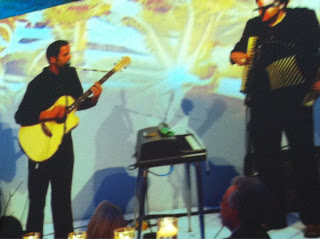
Proceeds from the evening will benefit National Geographic’s Explorer programs, comprising the Explorers-in-Residence, Fellows and Emerging Explorers. The “Evening of Exploration” was the culmination of the two-day National Geographic 2011 Explorers Symposium, an annual event at which National Geographic Explorers-in-Residence, Fellows, Emerging Explorers, grantees and others affiliated with National Geographic gather to share findings of their research and fieldwork and take part in panel discussions.
Cast Glass Sweeties
>
Sugar Bomb #3; Cast glass, 2011
Debra Ruzinsky
Bombshell, 2011
Debra Ruzinsky‘s cast glass artwork was recently praised by the Washington Post Art Critic Michael O’Sullivan in a review of glass sculpture that was on exhibit at Long View Gallery. In the review, Michael wrote: “My guilty pleasure sits all the way in the back of the 5,000-square-foot gallery… There you’ll find two small sculptural works by artist Deborah Ruzinsky, mounted on pedestals in front of large glass doors that, on sunny days, suffuse the room with light. The works’ titles, “Sugar Bomb #2” and “Sugar Bomb #3,” are apt. Cast in green and orange glass using Jell-O molds and artillery shell casings, they’re pure, explosive eye candy.
Staring at it, I feel like a monkey in front of a ball of shiny, shiny tin foil. Isn’t contemporary art supposed to be ugly — or at least less superficial?…
On the one hand, glass is pretty. It’s hard not to like the way it looks: the luminous color, the way it plays with light. On the other hand, maybe glass is only pretty. How do we know that the beauty is also capable of brains? The rest of the show is proof that it is.”
Debra checks her cast glass wafer ramp for smoothness.
Check back later for links to the Brattleboro Museum show.
Nice Rack
>
Patrick Truby with his bicycle rack design. Photo by Laura Wallach
Patrick’s mixed media glass sculpture is one of the works at Gallery 555‘s show of sculptural work by students of the Washington Glass School, currently on exhibit thru June 30, 2011.
 The Washington Glass School 10th Anniversary Student Sculpture Exhibit
The Washington Glass School 10th Anniversary Student Sculpture Exhibit
Gallery 555dc
555 12th Street NW Lobby, Washington DC 20004
202-393-1409 or 240-447-6071
Gallery555dc.com
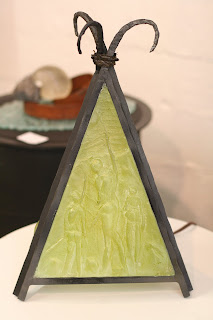
Cast glass and steel sculpture by Patrick Truby.
Congratulations Patrick & Alan!
Oh by the way – in case anyone wonders about how secure a “cool bike rack design” is – 
each rack has (4) 6” anchor bolts in the concrete and has one tamper-proof bolt. Someone who passes the rack on the way to work each morning says that it has been filled everyday.
The Party Was A Blast!
>This weekend, the Washington Glass School celebrated its 10th Anniversary with a big birthday bash held at Long View Gallery, where the exhibit Artists of the Washington Glass School: The First Ten Years was held. The critically acclaimed show had sold very well – much to the delight of both the gallery and the artists! Altho the Long View Gallery show is over – there still is time to catch work by the students of the Washington Glass School – over at Gallery 555dc – on exhibit until the end of June.
A big thanks to our artists, students, instructors, family, friends, supporters, aficionados – we all appreciate the love and support that allowed us to reach this milestone! Washington Glass School
Anne Plant describes her work.
Awesome Washington Glass School cake by theatrical designer Marie Schneggenburger.
Tim Tate lights the 10 birthday candles.
Directors Erwin Timmers, Tim Tate and Michael Janis lead the cheering and singing.
Blowing out the candles.
Altho this show is over :(
There will be more events and fun coming up, as the Washington Glass School moves on to the Next Ten Years.
GlassWeekend 2011
>
Tim Tate‘s video reliquaries on exhibit.
The international biennial glass symposium – GlassWeekend – was just held at Wheaton Arts in Millville, New Jersey – home of the Creative Glass Center of America and the Museum of American Glass.
The biennial event brings together artists, collectors, galleries and museum curators for a three-day weekend of exhibitions, lectures, demonstrations and social events.
Seven artists were chosen as “RISING STARS”, featured at GlassWeekend. The title of “Rising Star” indicates that these are the artists that the glass organizations believe to be the future of the medium.
Our Michael Janis was selected as a “Rising Star” by the Art Alliance for Contemporary Glass and the Creative Glass Center of America.
“Rising Star” artist Michael Janis at Maurine Littleton Gallery space. Photo: Linda Greene – AACG
Maurine Littleton Gallery space at GlassWeekend.
Allegra Marquart, Kari Russell-Pool & Paul Stankard take a break in the woods.
Allegra Marquart‘s work at Maurine Littleton Gallery.
The exhibition is a great snapshot on the direction the studio art glass movement is heading. The movement will hit the 50 years mark next year, and it is interesting to note that of the 16 “Rising Stars” named in the past two biennials, only 2 of them are traditional glass blowers, 1 is a ladle caster and the rest are warm glass artists. Does this mean that the glass world is finally giving kilnforming its props? One hopes!
Sibylle Peretti‘s work at Heller Gallery.
Mielle Riggie‘s (another Rising Star) kilncast dresses at Morgan Contemporary Glass
“Rising Star” artists discuss the medium during a panel discussion. L-R Michael Janis, Julius Weiland & Sungsoo Kim. Photo: Linda Greene – AACG
Kari Russell-Pool discussing her torchwork artwork in Duane Reed Gallery’s space.
Click HERE to jump to some more photos of the artwork on exhibit at GlassWeekend 2011.
The Atlantic City press has a nice mention of the events – click HERE to jump to the article.
Happy Birthday to US!
>
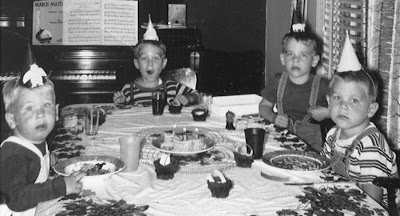 oh boy oh boy oh boy!
oh boy oh boy oh boy!
Join the artists of the Washington Glass School as they celebrate their 10th Anniversary with a birthday bash at Long View Gallery. The exhibit “Artists of the Washington Glass School: The First 10 Years” will close that night, and a party to celebrate is in order!
10th Anniversary Party
Long View Gallery
1234 9th Street, NW
Washington, DC 20001
Sunday, June 19th, 2011
2-5 pm
Click here to jump to the Post’s art critic Michael O’Sullivan’s review of the exhibit.
Glass History Lesson – Harvey Littleton 1962 Workshops
>
During the 1950s, studio ceramics and other craft media in the U.S. began to gain in popularity and importance, and artists interested in glass looked for new paths outside industry sources. At that time, access to glass was only through industrial production. Students were not taught hands-on techniques with the material; the craft of working with hot glass was still taught at the factories, under the apprenticeship system. The catalyst for the development of studio glass was Harvey Littleton, a teaching ceramist at the University of Wisconsin in Madison.
Informed by his own background in the material (he grew up in the shadow of Corning Glassworks, where his father headed Research and Development during the 1930’s), Harvey started experimenting with hot glass in his studio in 1958. He eventually realized that his desire to develop studio glassblowing could become a reality after experiencing limited success with his own glassblowing experiments.
The 1962 Toledo Workshop program
Harvey joined forces with the Toledo Museum of Art, the site of the “birth” of the American Studio Glass movement during two historic glassblowing workshops in 1962. He worked with glass research scientist Dominick Labino, who successfully devised a small, inexpensive furnace in which glass could be melted and worked, making it affordable and possible for the first time for artists to blow glass in independent studios.
Harvey Littleton subsequently started a glass program at the University of Wisconsin in Madison, and some of his early students were Dale Chihuly, Marvin Lipofsky, and Fritz Dreisbach, all artists who have played seminal roles in raising the awareness of studio glass around the world.Source: CMOG
As GlassWeekend 2011 gets started, The Washington Glass School Blog visited with Harvey’s daughter Maurine Littleton at her art gallery in Washington, DC, as she prepared for the exhibition. Maurine brought out some of the early glass pieces made by Harvey at the workshops.
Maurine Littleton discusses the early Harvey Littleton pieces. In the background are Harvey Littleton works ca 1986.
Two Harvey Littleton vases from the 1962 Toledo workshop. The pieces are engraved on the bottom with Harvey’s name and date.
Harvey’s first pieces in blown glass were, like his earlier works in pottery, functional forms: vases, bowls and paperweights. His breakthrough to non-functional form came in 1963 when, with no purpose in mind, he remelted and finished a glass piece that he had earlier smashed in a fit of anger. The object lay in his studio for several weeks before he decided to grind the bottom. As Harvey recounts in his 1971 book Glassblowing: A Search for Form, he brought the object into the house where “it aroused such antipathy in my wife that I looked at it much more closely, finally deciding to send it to an exhibition. Its refusal there made me even more obstinate, and I took it to New York … I later showed it to the curators of design at the Museum of Modern Art. They, perhaps relating it to some other neo-Dada work in the museum, purchased it for the Design Collection.”
Harvey’s birthday is June 14th – he turns 89 this year. Everyone here at the Washington Glass School sends Harvey Best Wishes for a Happy Birthday!
The Smithsonian Institution has a fascinating oral history interview with Harvey – made in 2001. Click HERE to jump to the SI web-link.

